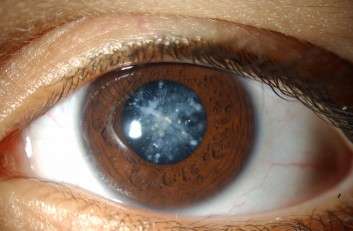CATARACT

WHAT IS IT?
A cataract forms when the lens of the eye becomes cloudy, probably because of changes in the proteins of the lens. Cataracts are extremely common; more than half of Americans age 65 and older have a cataract, and it is thought that nearly everyone will develop one if they live long enough. Cataracts take a long time to develop to the point that they are a serious problem for your vision. There are several types of cataract; the most common is called nuclear cataract because it affects the inside of the lens. Another common form is cortical cataract, in which the outside of the lens becomes cloudy.
SYMPTOMS
The main symptoms of a cataract are blurred, dulled vision in the affected eye, which cannot be corrected by wearing stronger glasses or contact lenses. In addition, you may find you need a brighter light for reading. Increased sensitivity to glare may also be a problem.Some cataracts can cause myopia growing fast ,and thats a symptom that makes old people see better when they read without reading glasses.
CAN IN PREVENT CATARACT FORMATION?
Smoking greatly increases the chance of getting nuclear cataract, the most common type in the US. So, the most effective way to lower your risk of cataract is not to smoke. (Note that this is the same advice given in the section on age-related macular degeneration, or AMD, a far more serious eye disease.) People with diabetes, even young people, often develop cataracts. Formation of diabetic cataracts can be slowed by keeping blood sugar under tight control. Even better, of course, is to maintain a normal weight; then you probably won’t get type-2 diabetes (by far the most common form of diabetes in the US) in the first place.
The scientific evidence for other preventive measures is weak, but suggestive.
Sunlight exposure may have a borderline effect on hastening the formation of cortical cataract. Antioxidants (especially vitamin C) and carotenoids in the diet may slow down the progression of some types of cataract, but the evidence is conflicting. The prudent thing to do is to eat several portions a day of fruits and vegetables, and to wear sunglasses and brimmed hats in bright sunlight. Even if it doesn’t reduce your risk of cataract, this behavior will help protect you against heart disease, skin cancer, and probably AMD.
TREATMENT
Cataract is the only truly curable eye disease (other than wearing glasses or contact lenses to correct refractive errors like myopia). Cataract surgery is the most common operation performed in the US; it is rapid, safe, and nearly always it is completely successful. A cataract needs to be removed only if it interferes with your vision enough to prevent you from driving, reading, or other essential activities. A “ripe” cataract can easily be extracted by an eye surgeon. Usually an artificial lens (called an intraocular lens, or IOL) is implanted in the eye during surgery, so that people no longer need to wear “coke-bottle” glasses. THE PROCEDURE IS COMPLETELY PAINLESS, NO STITCHES IS USED AND IT LASTS FOR 10-15 MINUTES. EYE DROPS IS INSTALLED FOR TOPICAL ANAESTHESIA.
CAN A CATARRACT REAPPEAR?
Certainly not , because the hole of the natural lens of the eye is removed. Very often the capsule behind the implanted iol may become hazy.This is called a secondary cataract and it can be dissolved with a laser application in an outpatient basis at the doctors office, within a minute. Vision restoration is dramatic after this painless procedure.
WHAT HAPPENS AFTER THE SURGERY?
Your eye remains with no patching ,and eye drops will be used for a period of 20 days. You can go home right after the surgery, and you are advised not to throw any water to the eye , avoid swimming with open eyes underwater and be careful with dusty and polluted areas for 7 days. You have to wear sunglasses and you can continue your daily routine.





